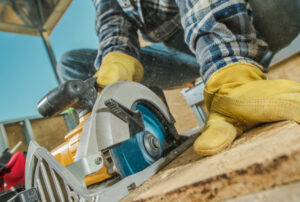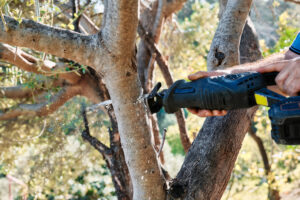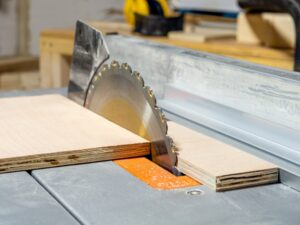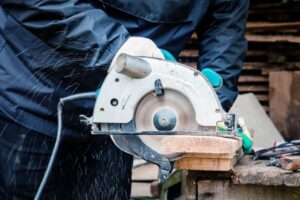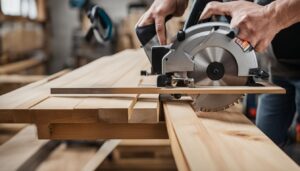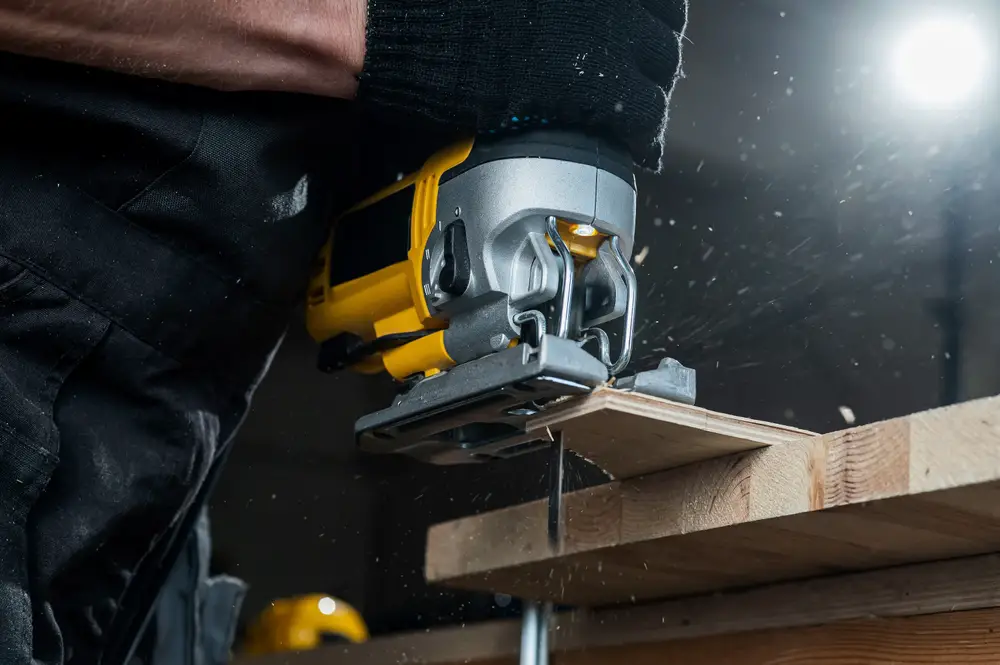
A jigsaw is a versatile power tool that can be used to cut curves in wood, metal, and other materials. It’s important to know how to use a jigsaw safely to avoid accidents and achieve precise and clean cuts.
In this guide, I will provide you with essential safety tips and proper usage techniques for using a jigsaw effectively.
Key Takeaways:
- Choose the right jigsaw based on your power, speed, and feature preferences.
- Familiarise yourself with the features of your jigsaw, such as variable speed dial and bevel adjustment.
- Wear safety gear, including safety glasses, dust mask, hearing protection, and safety shoes.
- Keep the work area clear and secure the material you’re cutting with clamps.
- Follow safe operating procedures and never apply excessive force.
Choosing the Right Jigsaw
When it comes to selecting a jigsaw for your woodworking projects, making the right choice is crucial. With a wide range of options available, understanding the key factors to consider will help you find the perfect handheld jigsaw that suits your needs and preferences.
Power is an essential consideration when choosing a jigsaw. Higher power ratings often result in faster cutting speeds and enhanced cutting capabilities, particularly when working with tougher materials. Corded jigsaws typically offer more power than their cordless counterparts, but cordless options provide greater portability and manoeuvrability.
Blade speed is another critical aspect to evaluate. Variable-speed jigsaws allow you to adjust the blade speed to suit different types of materials, ensuring clean and precise cuts. Additionally, features like orbital action and bevel adjustment offer increased versatility and flexibility, enabling you to achieve curved cuts and angled bevels effortlessly.
Table: Popular Jigsaw Models
| Brand | Model | Power Source | Blade Speed (spm) | Features |
|---|---|---|---|---|
| Ryobi | ONE+ R18JS-0 | Cordless | 1100-3000 | Orbital action, bevel adjustment |
| Makita | DJV182Z | Cordless | 800-3500 | Orbital action, bevel adjustment |
| Milwaukee | M18BJS-0 | Cordless | 0-2700 | Orbital action, bevel adjustment |
Some popular jigsaw models worth considering include the Ryobi ONE+ R18JS-0 18V Cordless Jigsaw, Makita DJV182Z 18V Brushless Jigsaw, and Milwaukee M18BJS-0 18V Compact Jigsaw. These models offer a range of features and power options to cater to different cutting needs. Remember to select a jigsaw that aligns with your project requirements and provides the necessary capabilities for tackling various materials.
By carefully considering factors such as power, blade speed, and additional features, you can confidently choose the right handheld jigsaw that will enhance your woodworking experience and deliver exceptional cutting performance.
Getting to Know Your Jigsaw
Before you start using your jigsaw, it’s important to familiarise yourself with its features and understand how to make necessary adjustments. Knowing how to operate your jigsaw correctly will not only ensure your safety but also enhance your overall cutting experience. Let’s explore the key features and adjustments you should be aware of:
Variable Speed Dial
The variable speed dial allows you to control the speed of the jigsaw blade. Adjusting the speed according to the material you are cutting is crucial for achieving clean and precise cuts. For softer materials, a slower speed is recommended to prevent splintering, while higher speeds work well for tougher materials.
Orbital Action
Many jigsaws come with orbital action settings. This feature controls the forward and backward motion of the blade, allowing for faster and more efficient cutting through thicker materials. Experiment with different orbital action settings to find the one that works best for your specific cutting needs.
Bevel Adjustment
The bevel adjustment feature allows you to tilt the base plate of the jigsaw, enabling you to make bevelled cuts at various angles. This is especially useful when cutting angled joints, creating decorative edges, or making precise angled cuts for projects like picture frames or furniture.
Trigger and Lock-On Switch
The trigger is the main power control for the jigsaw. Gently press the trigger to start the blade increase speed, and release it to stop the blade. Some jigsaws also have a lock-on switch that allows you to lock the trigger in the “on” position, providing continuous power without holding down the trigger. This can be convenient for longer cutting tasks.
Blade Clamp
The blade clamp is where the jigsaw blade attaches. Understanding how to securely attach and detach the blade is essential for safe operation. Different jigsaws may have different blade clamp mechanisms, so refer to your jigsaw’s manual for proper instructions.
Other Safety Features
Aside from these key features, it’s important to note other safety features on your jigsaw, such as blade guards and safety switches. Familiarise yourself with these features and always follow recommended safety precautions to prevent accidents and ensure a safe working environment.
Safety tips for using a jigsaw
When it comes to using a jigsaw, safety should always be a top priority. This versatile power tool can help you create precise and clean cuts, but it also carries potential hazards. By following these safety tips and adopting safe operating procedures, you can ensure a secure and productive jigsaw experience.
Wear appropriate safety gear
Before using a jigsaw, make sure to equip yourself with the necessary safety gear. This includes safety glasses to protect your eyes from flying debris, a dust mask to prevent inhalation of harmful particles, and hearing protection to safeguard against loud noise. Additionally, wear safety shoes to protect your feet from any potential accidents or falling objects.
Secure your work area
Before using a jigsaw, it is vital to prepare and secure your work area. Clear away any clutter or obstacles that may interfere with your movements. Secure the material you’re cutting with clamps to prevent it from moving or shifting during the cutting process. This will ensure stability and accuracy as you guide the jigsaw along the desired cutting path.
Follow safe operating procedures
Adhering to safe operating procedures is essential for a smooth and accident-free jigsaw experience. Never put your hands near the blade while the jigsaw is powered on. Instead, guide the tool using both hands, keeping a firm grip on the handle. Avoid applying excessive force as it may compromise your control over the jigsaw. Remember to never adjust a blade while the tool is still powered.
| Safety Tips | Description |
|---|---|
| Inspect equipment and blades regularly | Regularly check your jigsaw and blades for any signs of damage or wear. Replace any worn-out or damaged parts to ensure safe and efficient operation. |
| Keep fingers clear of the cutting line | Avoid placing your fingers in line with the blade’s path. This will help prevent accidental contact and potential injuries. |
| Work in a well-ventilated area | Ensure that your work area is well-ventilated to minimise the inhalation of dust and fumes generated during the cutting process. |
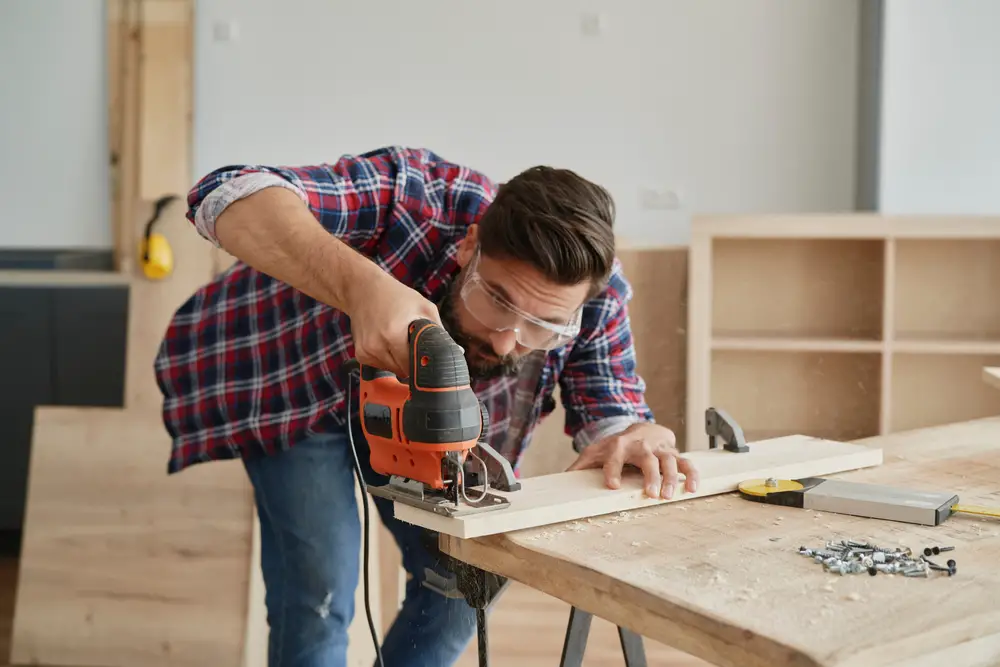
Conclusion
After learning about the essential safety tips and proper usage techniques for using a jigsaw, you can now confidently use this versatile power tool while prioritising your safety. Remember to choose the right jigsaw that suits your needs, ensuring it has the necessary features like variable speed dial, orbital action, and bevel adjustment.
Familiarise yourself with your jigsaw’s features and adjust them accordingly to achieve precise and clean cuts. Always wear safety gear such as safety glasses, a dust mask, hearing protection, and safety shoes when operating a jigsaw. Keep your work area clear and secure the material you’re cutting with clamps.
Never put your hands near the blade and avoid adjusting the blade while the jigsaw is powered. Regularly inspect your equipment and blades for any damage, and never apply excessive force during operation. By following these safety precautions and judiciously using your jigsaw, you can confidently tackle cutting projects and achieve excellent results.
FAQ
How do I choose the right jigsaw?
When choosing a jigsaw, consider factors such as power, corded or cordless, blade speed, and features like orbital action and bevel adjustment. Popular options include the Ryobi ONE+ R18JS-0 18V Cordless Jigsaw, Makita DJV182Z 18V Brushless Jigsaw, and Milwaukee M18BJS-0 18V Compact Jigsaw. Select a jigsaw that suits your projects and preferences.
What features should I be aware of on my jigsaw?
Familiarise yourself with the features of your jigsaw, including the variable speed dial, orbital action, bevel adjustment, trigger, lock-on switch, and blade clamp. Understanding how to adjust and operate these features will help you use your jigsaw safely and efficiently.
How can I use a jigsaw safely?
Wear safety glasses, a dust mask, hearing protection, and safety shoes when using a jigsaw. Keep the work area clear and secure the material you’re cutting with clamps. Avoid putting your hands near the blade and never adjust a blade while the jigsaw is powered. Regularly inspect your equipment and blades for any damage. Follow safe operating procedures and never apply excessive force.
- Drill Battery Maintenance: Essential Tips for Cordless Drill Battery Care - February 5, 2024
- Troubleshooting Drill Issues - February 5, 2024
- Quick Drilling Techniques - February 2, 2024

